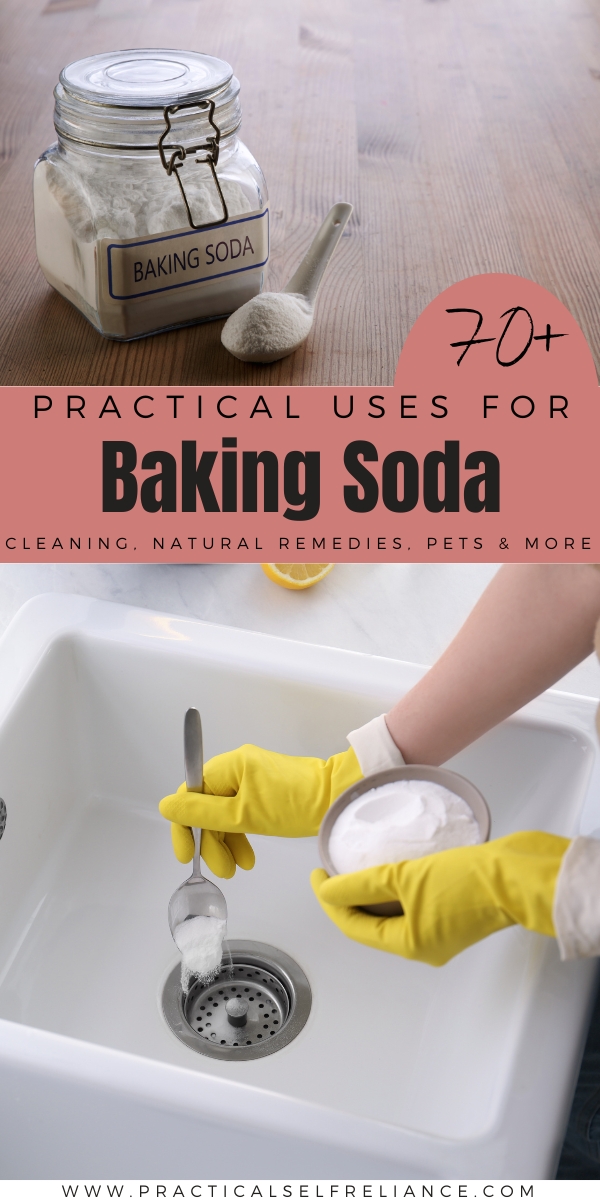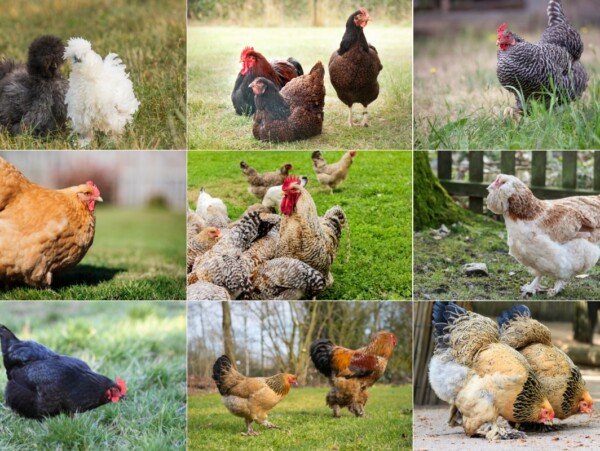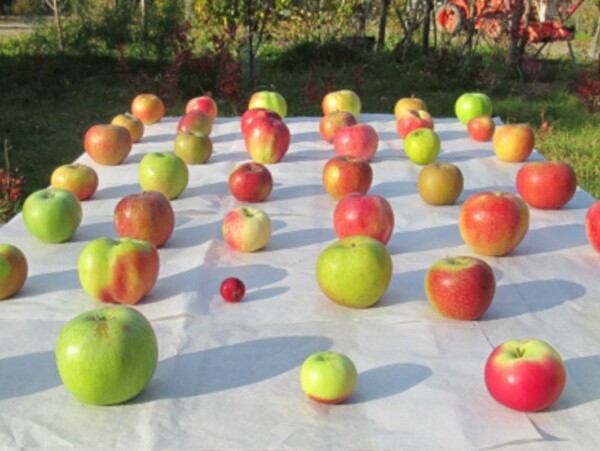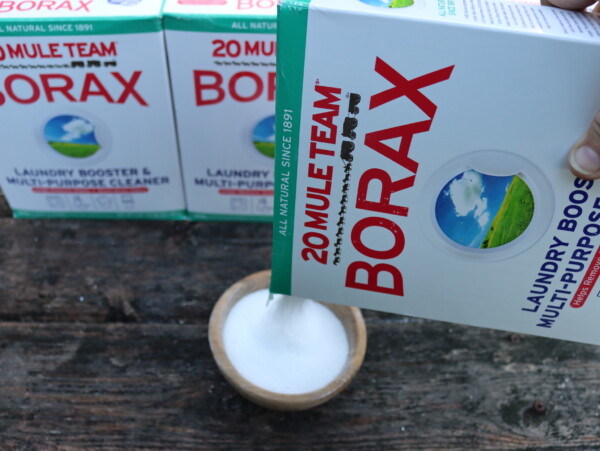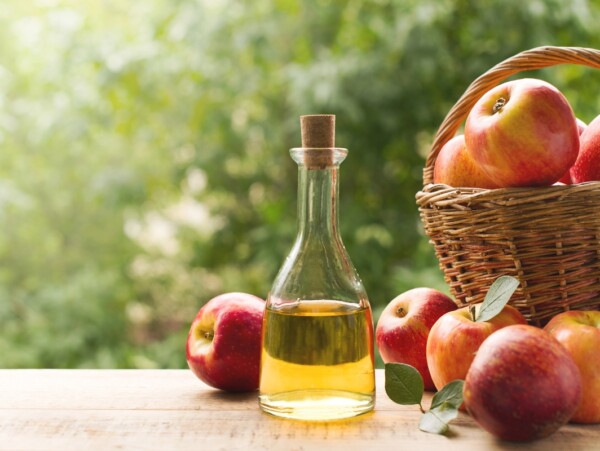Affiliate disclosure: This post may contain affiliate links. Please see our Privacy Policy.
Baking soda has an incredible number of uses, and not just in the kitchen.
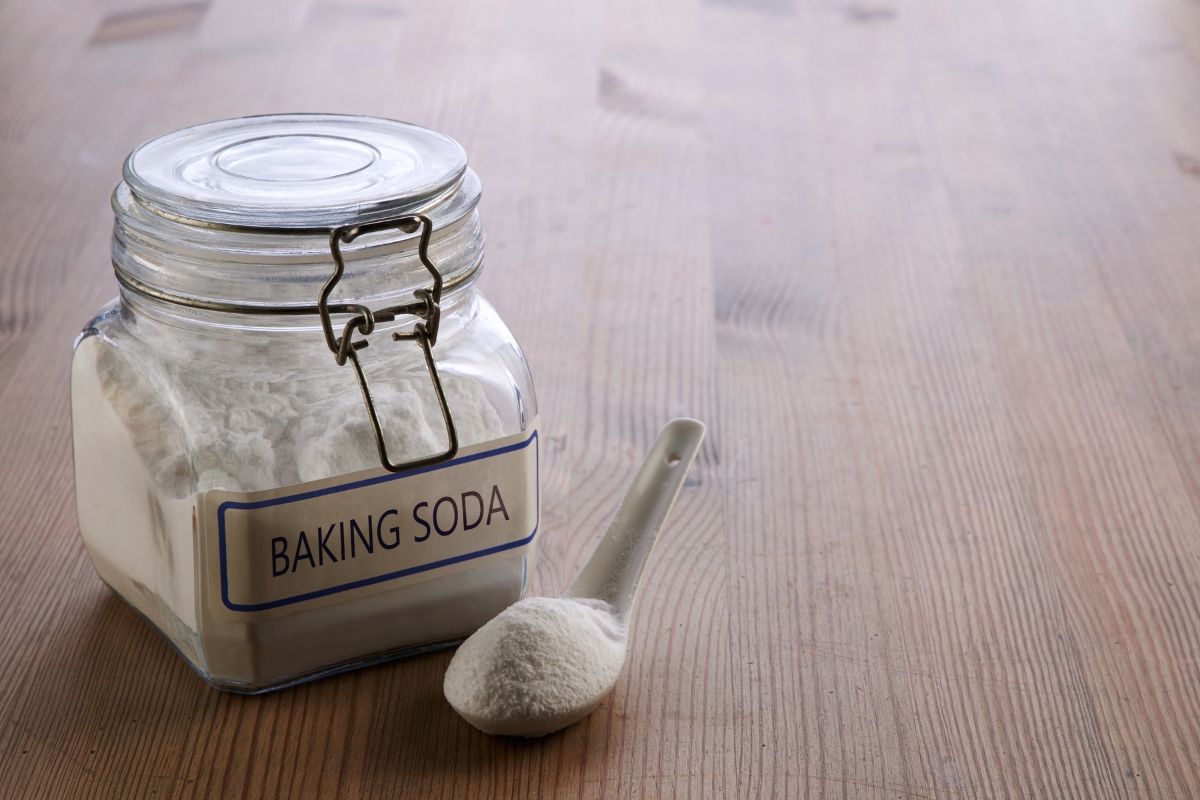
Table of Contents
- What is Baking Soda?
- Baking Soda Uses
- Baking Soda for Cleaning
- Fabric Freshener
- Stuffed Animals
- Burnt on Food
- Cutting Boards
- Steam Irons
- Tile and Grout
- Jetted Tubs
- Toilet Bowls
- Grime Remover
- Mildew Buildup on Shower Curtains
- Drains and Faucets
- Toothbrushes
- Baking Soda for Stain Removal
- Baking Soda for Deodorizing
- Baking Soda for Natural Remedies
- Relieve Upset Stomach
- Remove Splinters
- Soothe Irritated Skin
- Soothe Bug Bites and Poison Ivy
- Eliminate Sweet Tooth
- Care for Sores
- Prevent Cramps
- Household Uses for Baking Soda
- Wash Produce
- Keep Flowers Fresh
- Melt Ice
- Natural Laundry Detergent
- Put out Fires
- Set up Super Glue
- Air Up Balloons
- Garden Uses for Baking Soda
- Baking Soda for Personal Use
- Wearable Deodorant
- Mouthwash
- Toothpaste
- Homemade Bath Bombs
- Natural Dry Shampoo
- Homemade Exfoliating Scrubs
- Brighten Nails
- Clarify Hair
- Baking Soda for Pets
- Remove Skunk Smell
- Toenail Trimming Accidents
- Wet Shampoo for Dogs
- Dry Shampoo for Dogs and Cats
- Freshen Kitty Litter
- Clean Water Bowls
- Baking Soda for Cooking
- Leavening in Baked Goods
- Removing Bitter Flavors
- Soften Citrus Peels for Marmalade
- Peel Boiled Eggs
- Crisping Potatoes
- Fluffy Scrambled Eggs
- Tenderize Meats
- Bronze Pretzels
- Soften Beans
- Useful Household Staples
This article is written by Morgan Hyde, a reference librarian from Arizona. Her work for the library has refined her passion for learning and deep research—a passion that began in her rural AZ upbringing. If it’s something she can do on her own, it’s something wants know about.
Baking soda can be found in just about any well stocked pantry, and it’s used to leaven everything from buttermilk pancakes to banana bread. You’ve probably head about it’s cleaning and deo probably heard deodorizing uses, but that’s just the beginning.
There are so many practical ways to use baking soda around the house, in the garden, for pets and even as a natural remedy for a number of common everyday health issues.
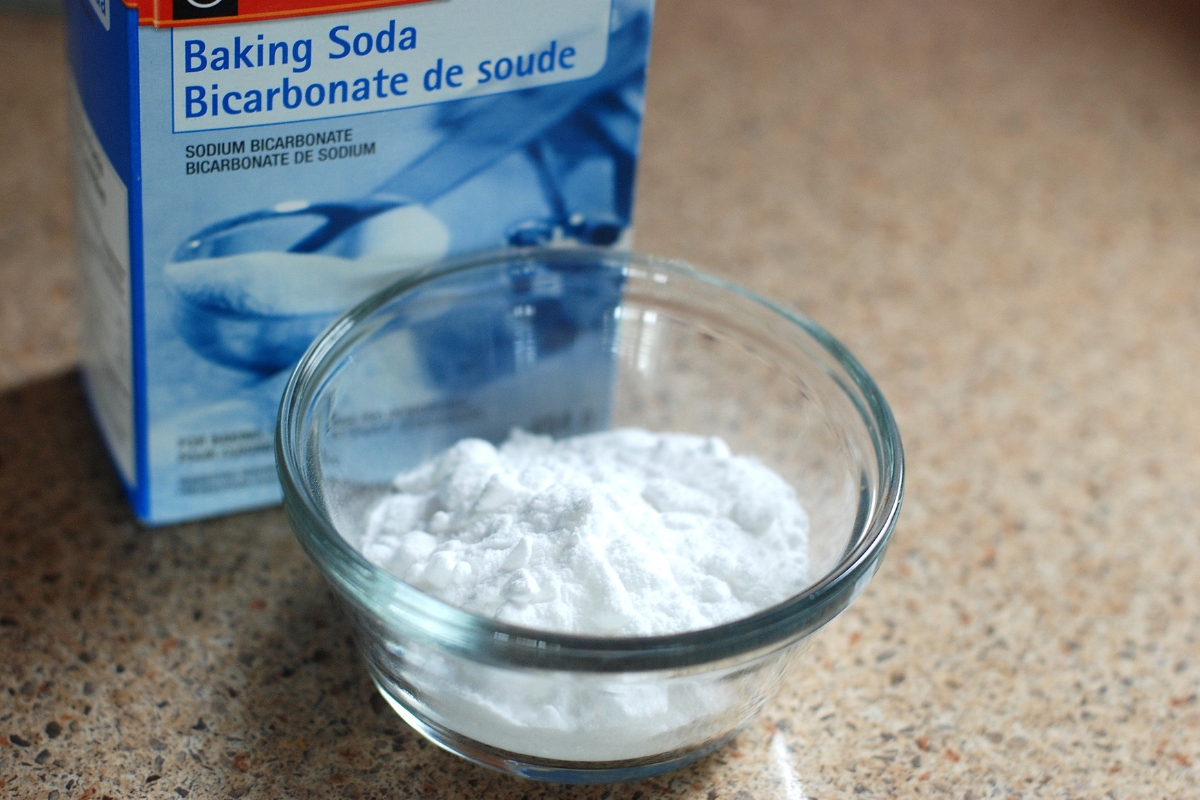
What is Baking Soda?
You probably have a box of it in your cupboards right now. Chemically known as Sodium Bicarbonate, Baking Soda has been a household staple since its introduction to markets in 1846. Before this, the process of leavening baked goods was labor intensive and took 12 hours to accomplish. Baking Soda was an instant success as a quick, scentless way to raise bread.
Baking Soda was originally derived from Soda Ash or Potash (Sodium Carbonate) through a system invented in 1790 called the Solvay Process. However, this system was inefficient and created a large amount of waste. As it happens, Baking Soda forms naturally in a deposit known as Trona Ore. Discovered in 1946, Green River, Wyoming, is home to a deposit large enough to meet the world’s demand for Soda Ash and Baking Soda for the next couple of thousand years.
But what exactly is Baking Soda? At its core, it’s a type of salt just like what you might find in the shaker on your table. Strangely enough, it’s considered an acidic salt despite landing on the base side of the Ph scale. When combined with acidic solutions, it reacts like a base chemical and releases CO2—which is how it adds air to make your baked goods fluffy!
Baking Soda Uses
Among the most versatile items you can keep in your home, Baking Soda is safe to use almost everywhere from your kitchen to your garden. It’s a natural cleaner and deodorizer but has its dozens of other uses as well!
- Baking Soda for Cleaning
- Baking Soda for Stain Removal
- Baking Soda for Deodorizing
- Baking Soda as a Natural Remedy
- Garden Uses for Baking Soda
- Baking Soda for Personal Use
- Baking Soda for Pets
- Baking Soda for Cooking
I’ll take you through all of those types of uses for baking soda, one by one.
Baking Soda for Cleaning
As a salt, Baking Soda is lightly abrasive and can give you extra power when scrubbing. It also has light antibacterial properties to help reduce any germs in the area you’re cleaning. Baking Soda can be safely combined with a variety of other household cleaners and can also act as a mild fungicide to combat mildew.
Fabric Freshener
You can use Baking soda to help remove dust mites and absorb moisture from fabrics such as your car’s trunk liner, carpets, or mattresses. Simply sift or sprinkle it over the surface you want cleaned, wait 30 minutes, and vacuum the area.
This method is generally safe for all fabrics you can think of from upholstery to curtains, but delicate materials should be tested in an unnoticeable area first.
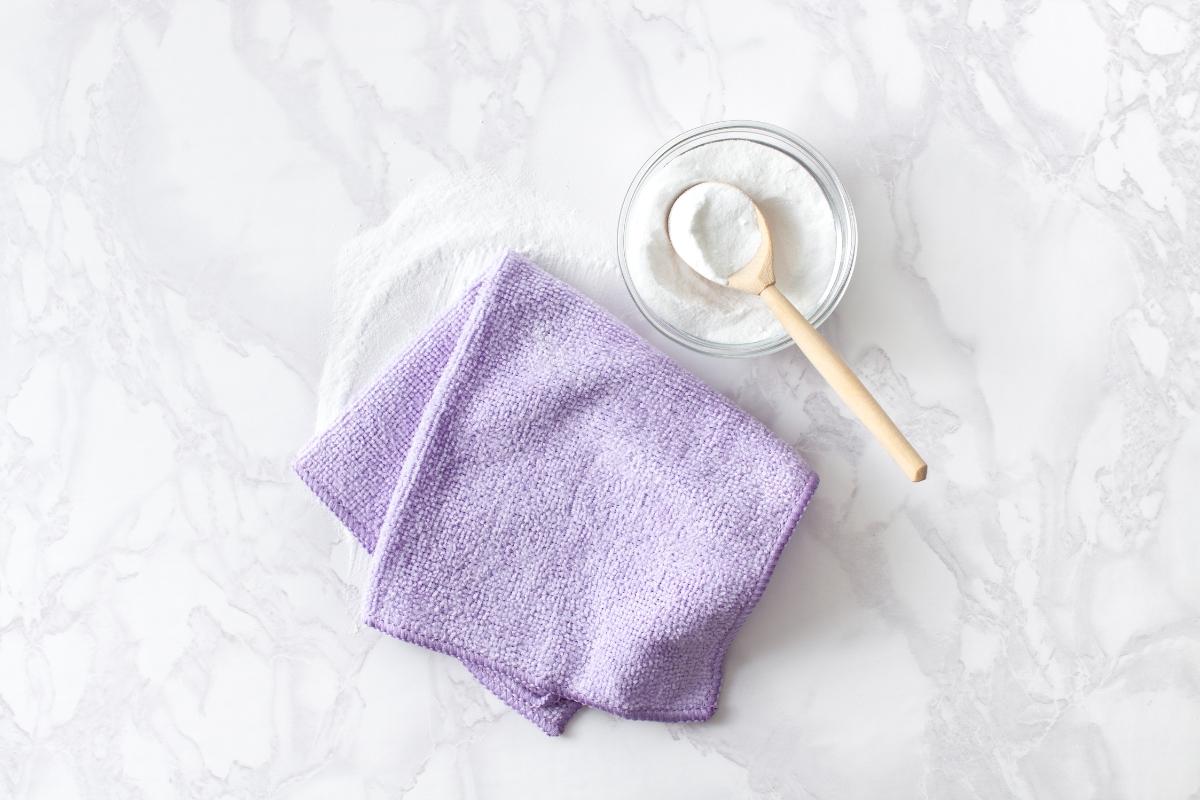
Stuffed Animals
While we might hope all our children’s toys can be dumped in the washer with the laundry, this isn’t always the case. Fortunately, Baking Soda is gentle enough, it can act as an at-home dry cleaner.
First, find a bag that will fit the stuffed animal (a zippered or garbage bag will work). Place the toy inside and add at least a ½ cup of Baking Soda, using more if you’re cleaning a large toy. Shake for 2 minutes or more and leave it alone for 15 minutes.
Remove the stuffed animal, shake off the excess powder into the trash, and vacuum or use a soft-bristled brush to clean the rest of the Baking Soda off. The toy should now be clean and smelling fresh again.

Burnt on Food
Baking Soda can add just enough extra abrasion to help break up food burnt onto the bottom of a pan.
You’ll want to put the pan or pot back on the stove and boil equal parts vinegar and water together. Make sure the mixture covers the burnt food and leave it for about 5 minutes (more, if it’s a big chunk). Empty your dish and sprinkle some Baking Soda inside.
Once it’s cooled sufficiently, add a bit more Baking Soda, and some salt, and scrub the rest of the food out.
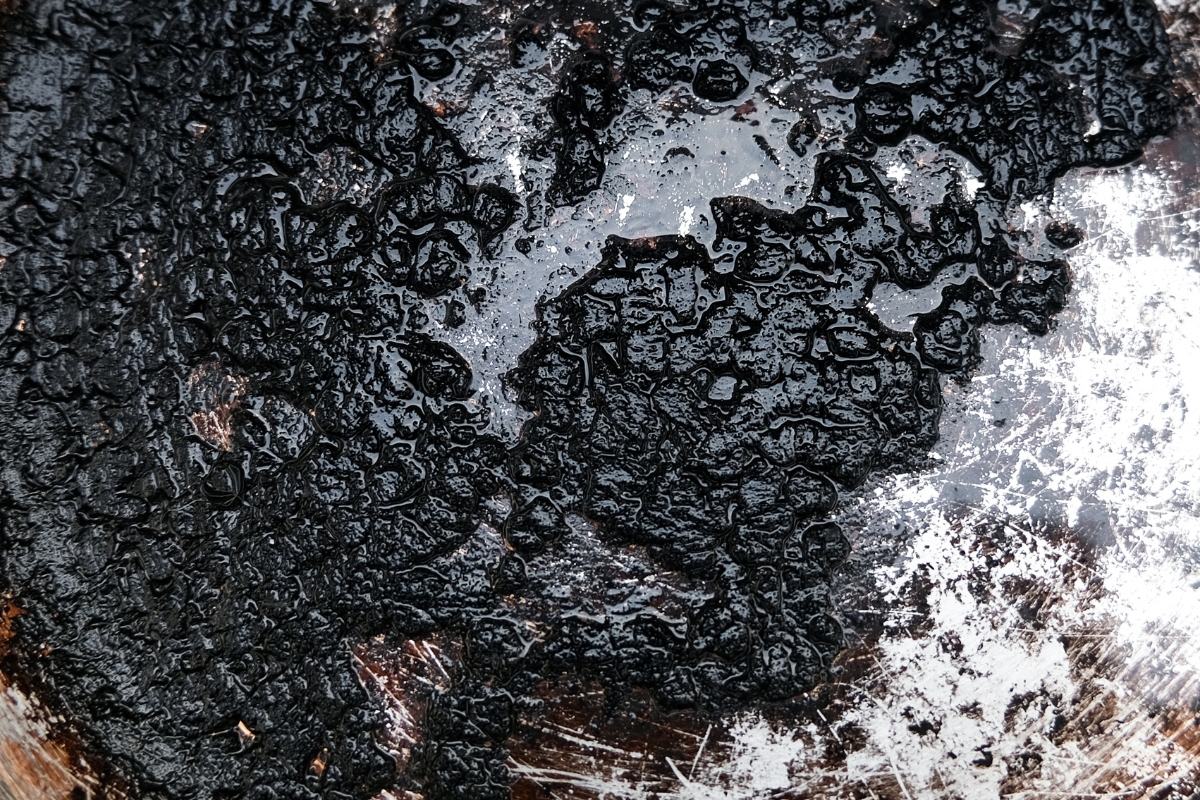
Cutting Boards
I always wash my cutting boards immediately after use and somehow still end up with stains from my food. Adding Baking Soda to the mix helps prevent the buildup of stains on your boards (and it may help lighten some old ones).
For wooden boards, scrape them with a soft spatula first. Then use a slurry of Baking Soda and water to lift away juices and oils. You’ll want to make your slurry watery enough to avoid adding more scratches to your board.
Plastic boards are a bit more time intensive to clean as they stain far more easily than wooden ones. Mix 4 tbs of Baking Soda, 1 tbs Dish Soap, and 2 tbs food grade Hydrogen Peroxide. Smear this onto the board and leave it alone for about 6 hours. You can then wash it like normal.
Steam Irons
While not something I regularly think to clean, steam irons do have a tendency to become grimy after prolonged uses.
You’ll want to mix 2 tbs Baking Soda and 1 tbs of water (vinegar also works but may leave a smell). Lather this on your iron with your hands, scrubbing gently. Avoid the steam vents as it’s tricky to get the slurry out once it’s in. Leave for a few minutes and then wipe off with a clean towel. Done!
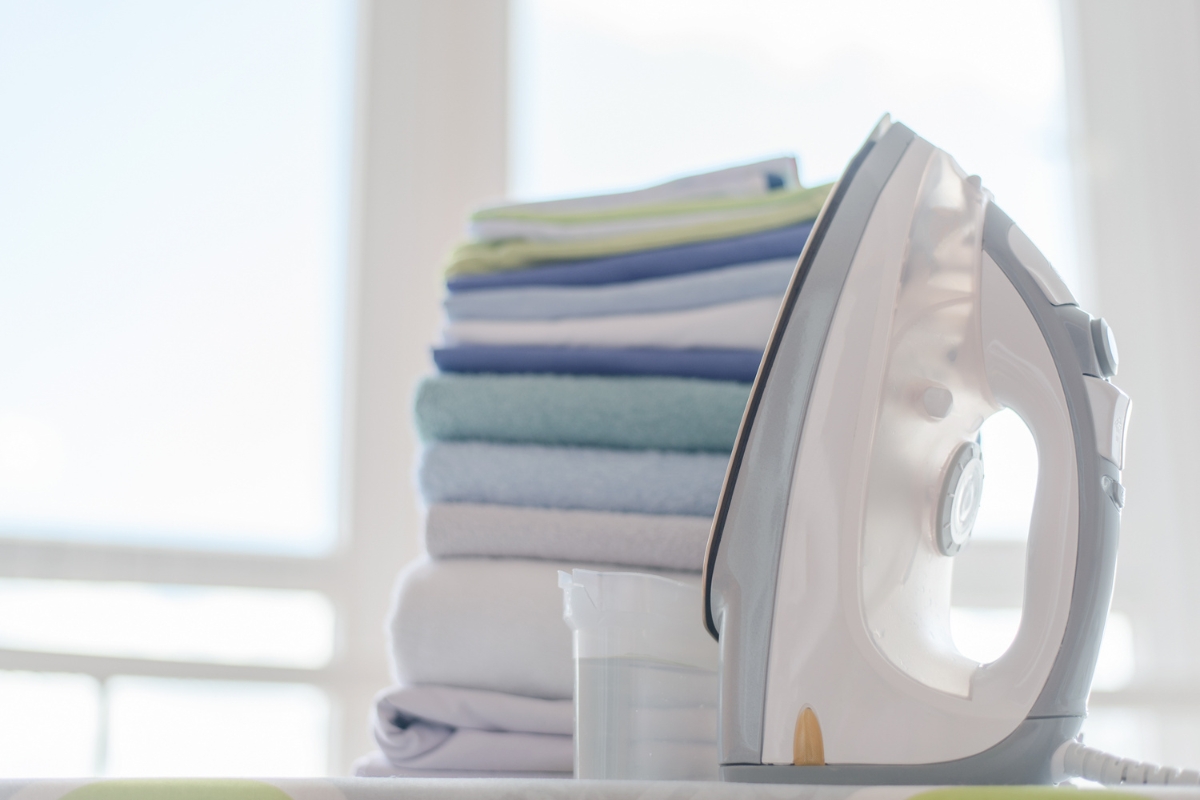
Tile and Grout
Alright, this one is going to highly depend on the combination of tile, grout, and sealants you have. Test this method out on a small, unobtrusive area first to make sure you won’t damage anything. Avoid using Baking Soda on marble as it will dull the finish.
Baking Soda can be used on most tiles as an abrasive to scrub up stains. Sprinkle it in the area you would like to clean, leave it for at least 10 minutes, and use a damp cloth or sponge to scrub at the spot. Wipe up or rinse off any excess.
Grout is much trickier and can crumble if not handled carefully. First, mix 3 cups of Baking Soda with 1 cup of water. Use less baking soda for less abrasion on softer grouts. Next, lather the slurry onto your grout and leave it for 5 minutes. Either scrub with a sponge or immediately rinse your grout.

Jetted Tubs
Having a clean jetted tub is a labor-intensive process, but so worth the peace of mind a fresh bath brings. You will need to know the manufacturer’s information for this process, so go ahead and dig up that user manual.
Remove any debris in your tub, like hair or dirt, and fill the tub enough to cover your jets. Add a few cups of white vinegar to the tub. If recommended for your appliance, close the intake valve to allow for a deeper clean. Run your jets until no gunk or dirt appears.
After emptying your tub, fill it again with just water. Run the jets again to rinse them out and empty the tub once more. Sprinkle Baking Soda anywhere it’s needed including around (but not in) your jets. Use a sponge to scrub away buildup or mildew. Then use a toothbrush dipped in Baking Soda to clean around your jets. Rinse and voila!

Toilet Bowls
Sometimes it seems like your toilet scrub brush just isn’t pulling its weight—and that’s because it isn’t. Toilet bowls are prone to buildup, particularly in areas with hard water.
To fix this, add 2 cups vinegar to the bowl and swish it around with the brush to cut through any limescale. Let it sit. Add 1 cup of Baking Soda and leave it for 1 minute. Scrub the entire interior of the bowl to make sure the mixture reaches all areas. Let it sit until it’s all settled into the bottom again and flush. Done!
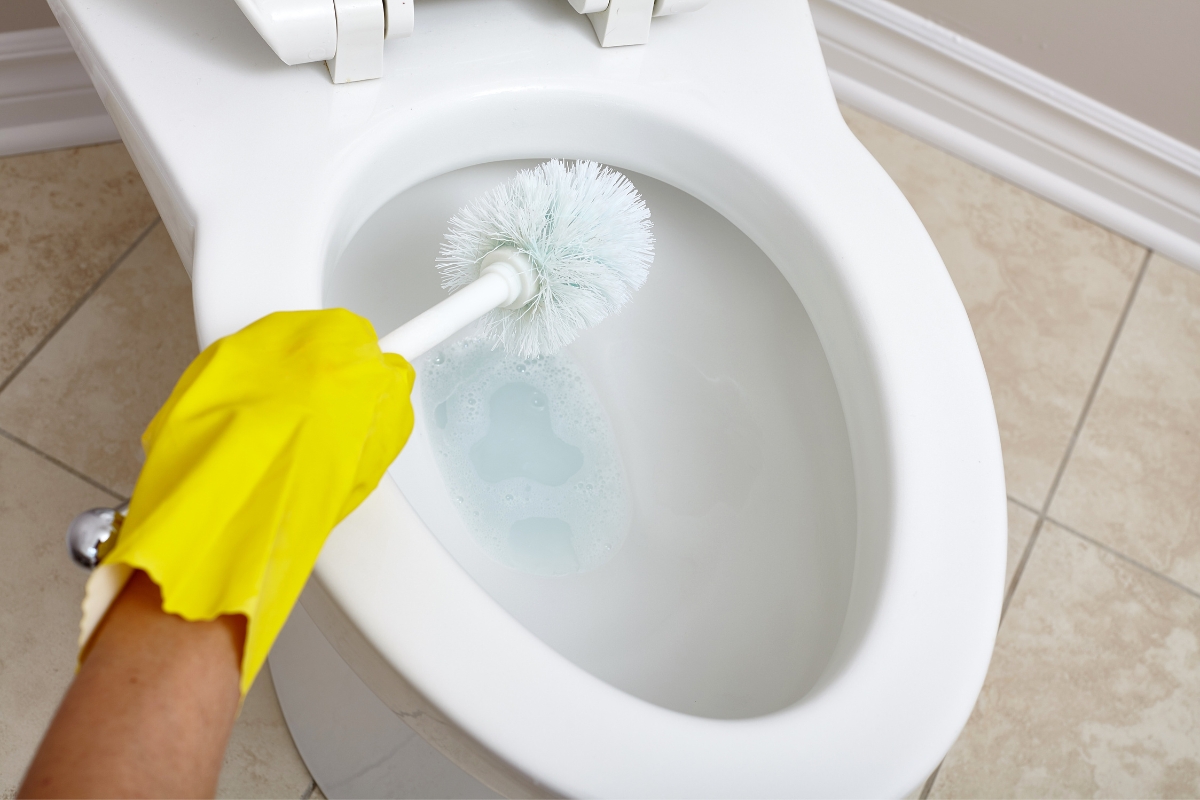
Grime Remover
Various parts of the house begin to look dull and gritty after a while, particularly things touched often—doorknobs, window edgings, the oven handle, etc. There’s no other way to describe them than just… grimy.
You can use Baking Soda as an all-purpose grime remover by pouring it over the area and leaving it alone for half an hour. Wiping it off with a damp sponge, scrubbing a bit as you go, should reveal a clean and clear surface.
If the grimy thing in question is not a horizontal surface, you can spritz it with water first to help the baking soda adhere. Then let it set and wipe it like normal.
Mildew Buildup on Shower Curtains
I have been guilty in the past of just buying new shower curtain liners when mine begin to look foul. It turns out I could have just cleaned them off and saved myself a trip to the store. Baking Soda is a natural fungicide and will not just lighten mildew, but also kill it completely.
Take down the curtain and lay it out in an open area. Sprinkle some Baking soda on a microfiber cloth and scrub the curtain. Carry it back to the bathroom and rinse it off in the tub. For stubborn buildup you may need to go through the process a few times.
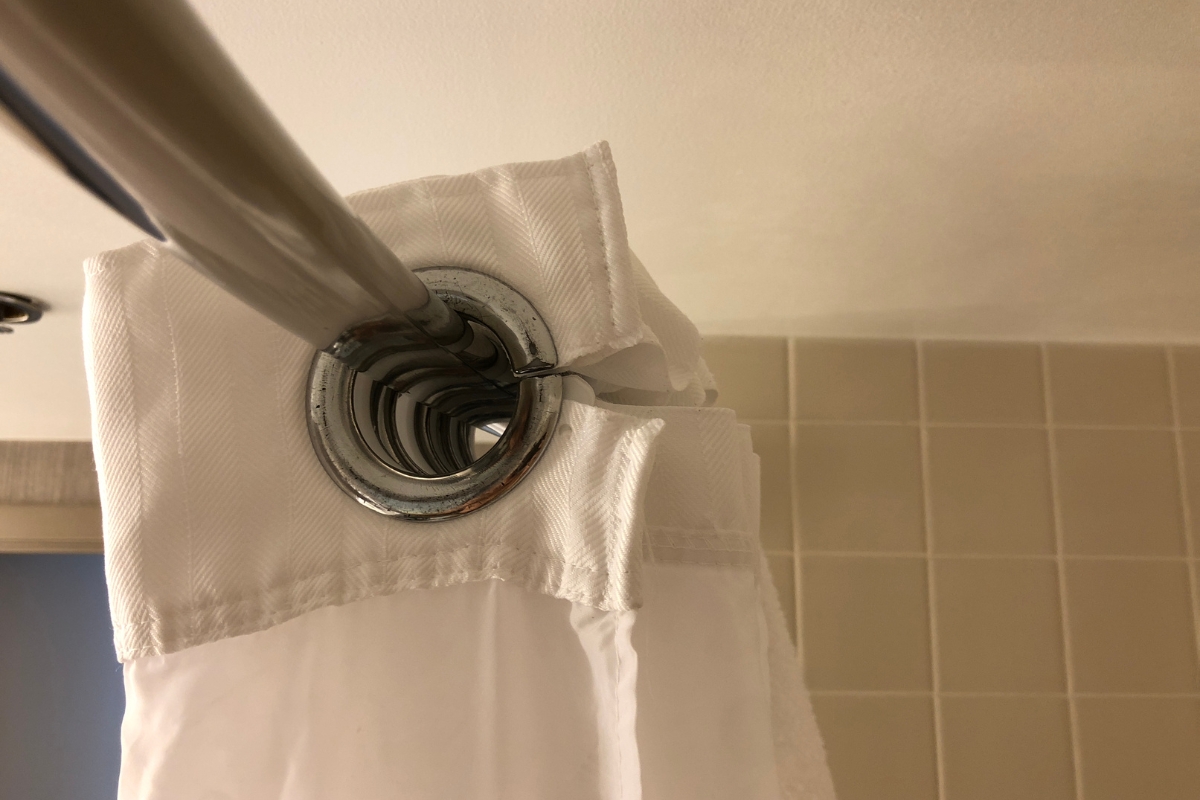
Drains and Faucets
After a while, even by wiping them down regularly, drains and faucets begin to look a bit dull. Rather than spend an hour scrubbing at the buildup, go ahead and mix Baking Soda with vinegar into a thick paste. Smear it all over your faucet and drain covers and leave it for an hour or so. Then wipe it away!
Not only will this shine your fixtures, it also will help cut through limescale by holding the vinegar in place for a while. My shower head doesn’t change angles easily and the paste often just drops off. Like me, you may need to remove the shower head before applying your slurry.
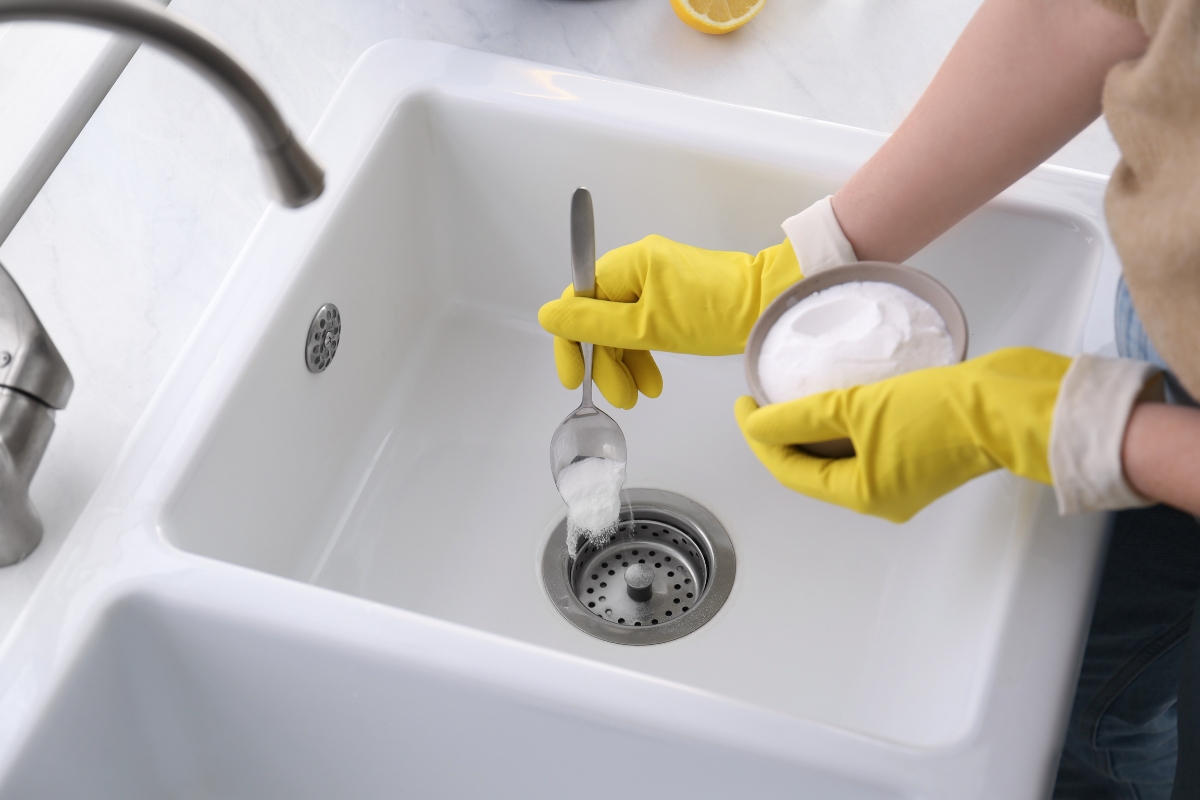
Toothbrushes
Rinsing your toothbrush after every use is a great way to help maintain it. A little regular Baking Soda can also sanitize and clean it.
If you mix 2 tbs of Baking Soda with 1 cup of water, you can soak your toothbrush overnight. Then, in the morning, swish it in the mixture for 30s seconds. Rinse it with clean water, and voila! It’s good to go for your morning cleaning.
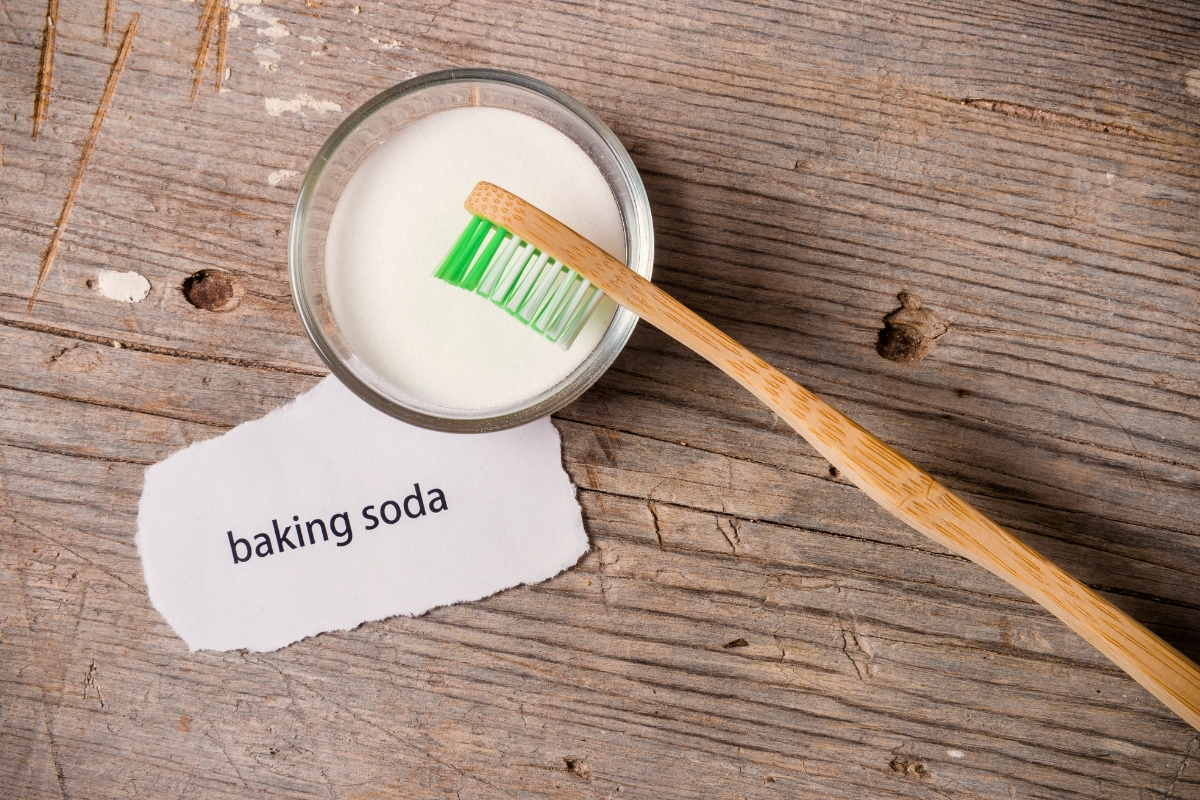
Baking Soda for Stain Removal
More cleaning? Yes, but we’re now going to look specifically at those applications of Baking Soda that will help prevent stains or break up old ones.
Baking Soda is highly absorbent and great at soaking up anything that might stain a fabric. Further, as an abrasive and an alkali, it’s particularly great with old stains on a variety of surfaces.
Walls
Once again, you’ll want to check in a hidden area to make sure this process won’t discolor, scratch, or otherwise damage the paint on your walls. I’d recommend using soap, water, and a cloth first to remove what you can. Any stains that remain can be addressed using the process below.
Combine ½ cup of Baking Soda with a bucket of water, remembering that less water means it will be more abrasive. Dunk a cloth into the bucket and scrub your walls.
This method is particularly good at lifting stubborn marker and crayon that may have been happily and artistically used on your walls.
Clothes
Sweat stains are the nemesis of many in the summer months. We try to stay cool, but…
If regular washing won’t lift the salty buildup, start by soaking the garment in warm water (soaking it in 1 part vinegar and 2 parts water will give you a bit more cleaning power). Next, mix 1 part Baking Soda with 2 parts hydrogen peroxide. Apply it to the stains and scrub at them with a toothbrush. Leave it for 20 minutes or overnight, then wash like normal.
For a color protective method, use water instead of hydrogen peroxide. While most dyes won’t run from just Baking Soda and water, you may want to do a spot test first.
Hats
Sweat stains again! But now for things that may not be safe for a washing machine.
Check for care instructions and do a bleed test first. Some hats can’t handle being washed at all or they’ll lose their shape.
If you have a green light, go ahead and make a paste of Baking Soda and vinegar. Use your fingers to scrub the paste into the stained areas until it clears up. Then hand wash it in a sink with some laundry detergent. Set it out to dry, if possible in a way that will support the hat’s shape.
Carpets
If you knocked over a plate of food or your pet made a mess on the carpet, getting to it quickly with some Baking Soda will draw out stains before they set in. On your way to the kitchen, identify if the mess is greasy or oily.
If it isn’t greasy, blot the spot dry and sprinkle Baking Soda generously over it. Cover it with a damp towel and leave it for 3 hours before vacuuming it up.
Greasy stains will start the same—blot the area and sprinkle on your Baking Soda. But don’t cover it with a damp towel. Oils are hydrophobic and won’t absorb well if your Baking Soda is wet. Leave the stain alone overnight if possible before vacuuming it up.
The more was spilled, the more likely you’ll need to repeat this process a few times.
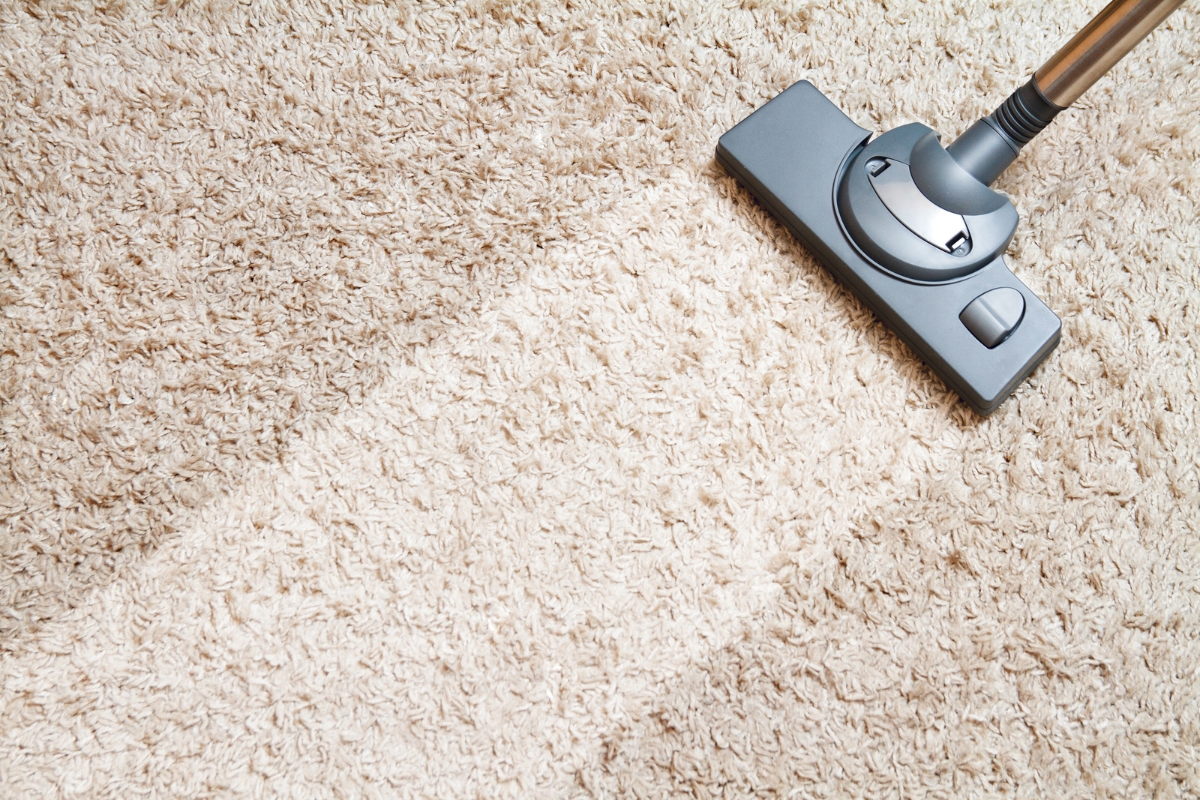
Mattresses
Changing your sheets and cleaning your mattress regularly won’t necessarily prevent stains from forming. Whether it’s from sweat or a child’s nighttime accident, use this method to remove any unpleasant stains that have set in:
In a spray bottle, mix 1 cup hydrogen peroxide (3%) with 3 tbs of Baking Soda and a drop or two of liquid dish soap. Spritz the mixture onto the stain until it’s covered but not to the point of soaking the fabric. Leave it to dry for at least an hour.
Then vacuum the area, or wipe it with a dry towel.
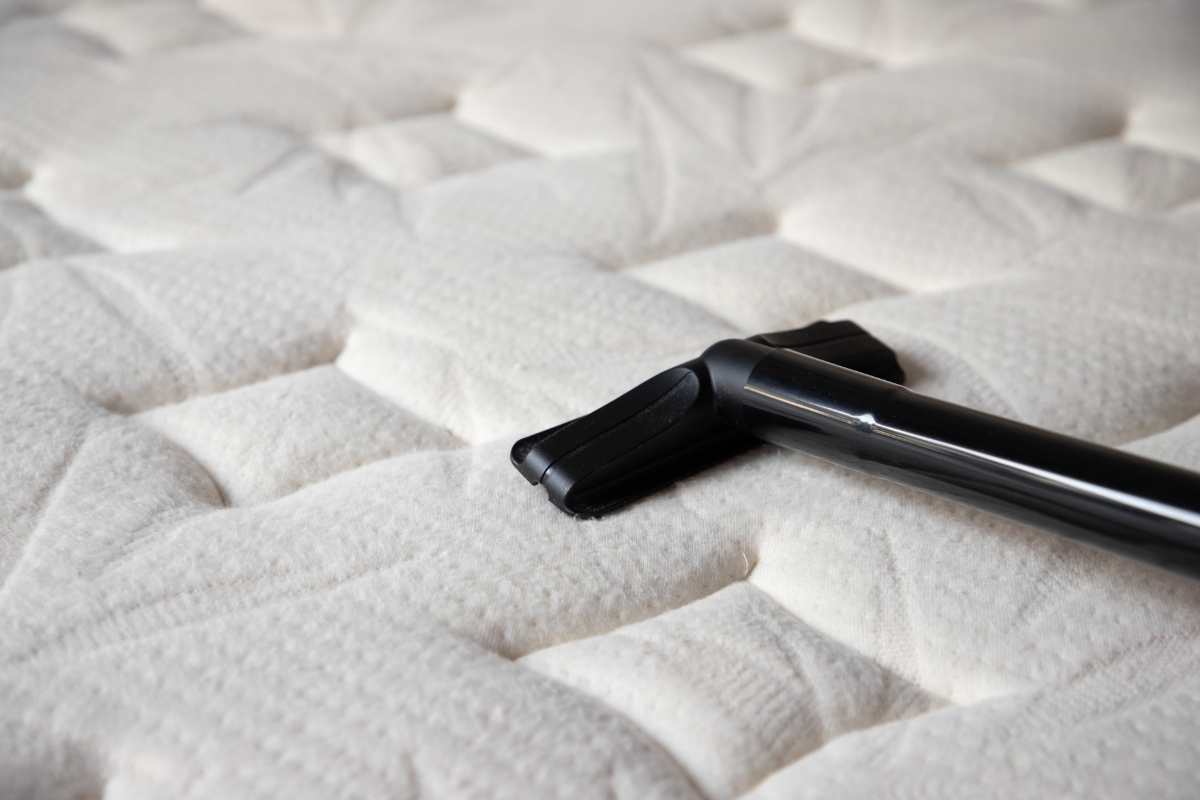
Mugs
Tea and coffee stains begin to appear in my mugs after about a month. Rinsing right away and using a scour pad doesn’t do anything to stop the process of painting the insides of my favorite mugs a light brown.
Fortunately, it’s not permanent. If you sprinkle some Baking Soda into the mug and add water to your sponge, the extra abrasion will help lift the stains right off. Rinse and dry like normal.
Silver
First introduced to me as a science experiment, Baking Soda bypasses the weary “elbow grease” method of polishing oxidation off of silver.
You’ll need an aluminum pan or a glass tray lined with aluminum foil (shiny side up). Place your silver in the pan and boil enough water to cover all of your items. Add Baking Soda into the pan at 1 cup of soda per gallon of water. Wait 30 minutes. Remove your silver, rinse it, and dry it. You’re done!
Brass
Like silver, brass also tarnishes after a while and needs buffing. Unlike silver, though, some scrubbing is required. Before you begin, check to see if your brass is lacquered. Baking Soda will damage the finish of lacquer; soap and water should be enough to clean it instead.
Wash your brass item first with warm water and a bit of soap. Dry it well with a microfiber cloth. Next, make a paste of 1 cup Baking Soda and ¼ cup Vinegar. Wait for it to stop fizzing and lather it onto the brass. After 30 minutes use a soft cloth to scrub at any tarnish. Rinse and dry like normal.
Baking Soda for Deodorizing
Baking Soda has a Ph of 8.5, making it a mild base that’s very close to neutral. It pulls things it’s in contact with closer to its own Ph. When Baking Soda comes into contact with odors, this has the effect of reducing or eliminating the smell entirely.
Smoky or Sweaty Clothes
Even if there’s no physical evidence you’ve been near a campfire or hiking recently, sometimes it’s still obvious. Washing will pull most smells out of your favorite garments, but for stubborn smells you can turn to Baking Soda to fully remove it.
Fill a bucket or sink with water and add ½ cup of Baking Soda. Soak the clothes, stirring them occasionally. Remove and lightly wring out the excess water before placing them into your washer like normal. Especially sweaty or smelly clothes may need to soak overnight.
Oily Clothes
Gasoline and other oily smells are particularly difficult to get rid of, even more so if you spilled some on your clothes.
Grab a bag and add in Baking Soda and water. Insert your clothes and seal as best you can—they’ll need to soak for a full day or two. Once soaked, you can wring them out over a sink and place them in the wash.
Especially oily clothes should be hand washed after they soak. This will help prevent the oil from spreading in the washer and potentially affecting your next few loads.
Rubber Gloves
Want to avoid having your hands smell like latex or rubber the next time you finish cleaning? Sprinkle some Baking soda into the gloves first before you put them on. Your hands should smell normal after.
Be careful not to add too much or you may find your hands feeling a little raw when you’re done.
Tupperware
Stains in Tupperware are one thing. Smells are another—I don’t like putting fresh food into a container that smells like a combination of its last three meals.
Deodorize your plastic containers by mixing ¼ cup Baking Soda and 1 cup vinegar in a bowl. Add in your Tupperware, and fill the bowl with enough water to cover all items including lids. Soak for a day or two and wash them thoroughly. All smells should be gone!
Refrigerators
Your fridge is clean but there’s a smell lingering from the broccoli you didn’t see tucked in the back of the drawer until too late. Placing 1 cup or more of Baking Soda into a shallow dish and setting it near the odor will help remove it.
Some people recommend following this process at all times and swapping the Baking Soda out every 3 months. I’ve found it’s more effective for treating noticeable smells than preventing any (mostly because I forget to change the Baking Soda).
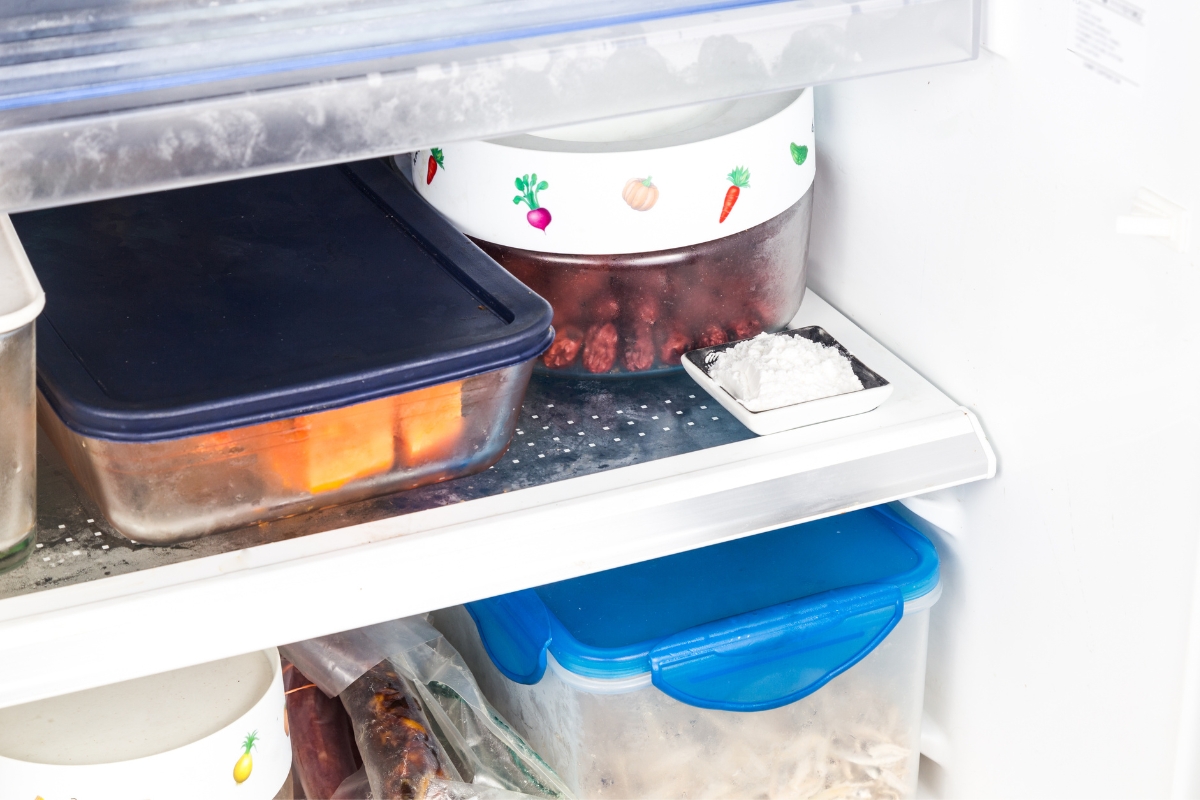
Shoes
The most universal Baking Soda use for deodorizing shoes is to create a sachet and leave it in or near your shoes. You can make a sachet at home by placing ¼ cup Baking Soda into a piece of cloth—the toe of a sock works great! Add a few drops of essential oil for scent and close it with a string or rubber band.
For cloth shoes, you can sprinkle Baking Soda directly onto them. Leave it for 24 hours and shake off the excess. Leather and suede shoes shouldn’t come directly in contact with Baking Soda if you can help it.
Trash
In most cases, taking out the trash will solve any order issues in that area of the kitchen. But occasionally, it lingers due to spills, leaks, or forgetting food in there when you go on vacation.
I’d recommend starting with a clean trash can—if you have an outdoor hose, that works wonders for getting gunk out. From there, sprinkling ¼ to 1 full cup of Baking Soda in the bottom of the can before placing the bag will help absorb odors for about a week.
Smelly Drains
Do you wonder how you clean a place you can’t reach with your hand sponge and cleaners? I do, each time I rinse something nasty down the kitchen sink. I especially wonder when it begins to smell.
Start by pouring boiling water down the drain. Next, combine Baking Soda and either vinegar or lemon juice together—enough to get the mixture frothy. Pour this down the drain and run your disposal (if the drain has one). Let it sit for a few minutes, placing a drain plug or a flat plate over the drain. Then, pour another round of boiling water through the drain.
Not only will this process sanitize and deodorize the drain, it also will help break up any light clogs that may have formed.
Hands
Soap does not always remove the smell of food from your hands when you cook. Baking Soda, on the other hand, does.
Combine 2 tbs dish soap with 1 tbs salt and 1 tbs Baking Soda. Coat your hands completely, including under your nails. Wait about 30 seconds and rinse your hands under running water, scrubbing lightly. All food smells should be gone!
Baking Soda for Natural Remedies
Baking Soda is a common ingredient in many over the counter products ranging from antacids to toothpastes. While it is safe for general use and to ingest, use it cautiously and in very small doses the first few times you try it. Some people find they are especially sensitive to Baking Soda.
Relieve Upset Stomach
Plagued by heartburn? Suspect you might have a stomach ulcer? Drinking ½ tsp of Baking Soda with a full glass of water can help by bringing the Ph of your stomach closer to neutral.
You may need to take this remedy once every two hours for it to start having an effect. Many people find it best when used 1-3 hours after eating, but not immediately after.
Remove Splinters
Tweezers seem to be mostly effective for splinters if you have steady hands and good eyesight. Even then the little sliver can bury itself deeper when you try to get it out.
To help the process along, make a thick paste out of Baking Soda and water. Smear it on the area with the splinter and put a bandage over it. After a day, uncover it. You’ll notice your skin is softer and the splinter has likely swollen—making it much easier to grab with those tweezers!
Soothe Irritated Skin
Lotion can only get you so far if you’re suffering from cracked, raw, or sunburned skin. For any skin irritation you experience that covers a large area, taking a bath with Baking Soda can help relieve your symptoms.
This is especially helpful for small children with diaper rash—they might not like having creams put on, so let them play in the bath instead.
Add ½ cup Baking Soda to warm water that’s thigh-high in the bath (use more if filling your tub higher). Soak for 10-15 minutes or until your water becomes chilly.
Soothe Bug Bites and Poison Ivy
Baking Soda can relieve minor irritations, pain, itching, and/or redness caused by things like mosquito bites or poison ivy. You can bathe in the Baking Soda. Or, if it’s smaller scale and not worth running the water, you can make a topical treatment instead.
Mix up a paste of 3 parts baking soda to 1 part water. Smear it on your skin and leave it for 20 minutes before you wash it off. Use running water and let the mixture wash off on its own as much as you can. Rubbing your skin to dislodge the treatment may cause greater irritation.
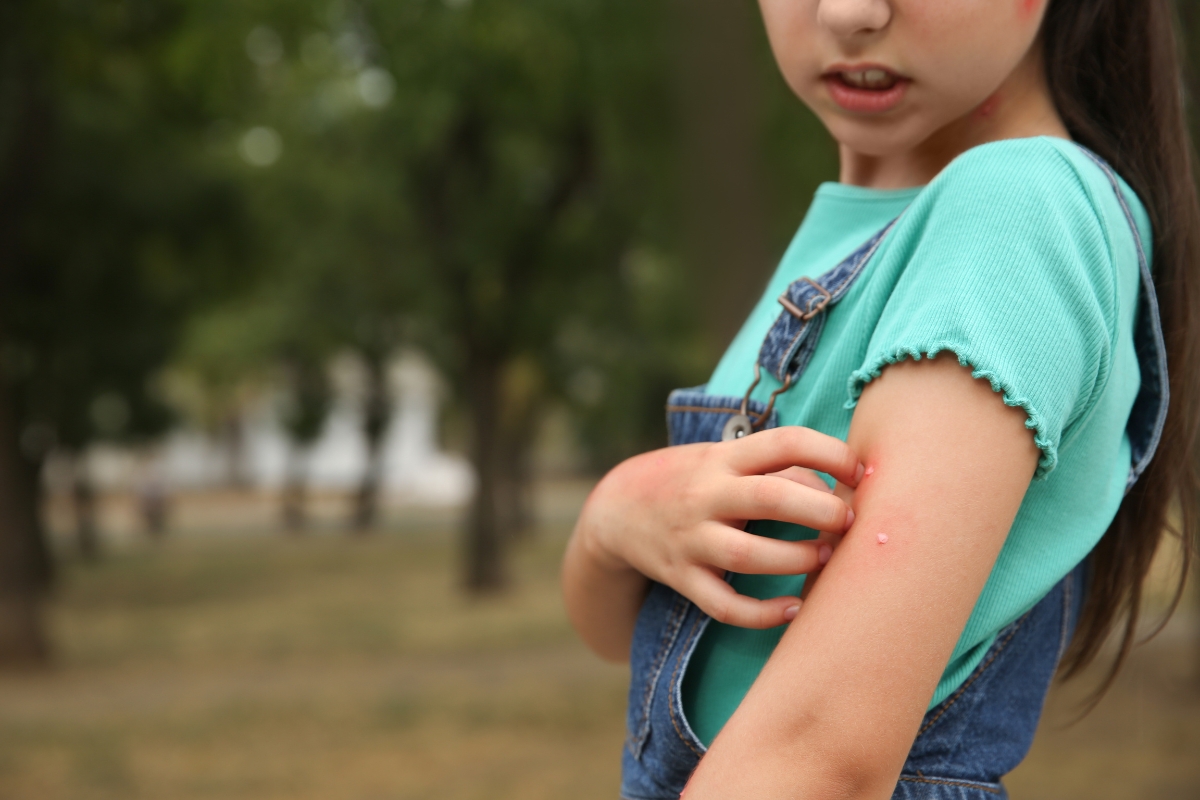
Eliminate Sweet Tooth
While not a malady, per se, having an overwhelming craving for sweets when you’re avoiding them or don’t have any on hand can be brutal.
When you feel the craving come on, mix 1 tsp Baking Soda with warm water. Swish it in your mouth for a minute or two and rinse it out. Your craving should be gone!
Care for Sores
Whether it’s a small cold sore or sores from shingles, when they appear you just want them gone.
After washing the area around the sore, take a pinch of Baking Soda and place it directly on the sore. Leave it and try not to touch the area. Eventually the Baking Soda should either fall off on its own or be fully absorbed and help dry out the sore.
Similar to sores on your back or face, Baking Soda can help speed up recovery from sores in your mouth! Use it as a mouthwash (see below) 3 times a day.
Prevent Cramps
Proper hydration and exercise practices will do the most for helping you avoid cramping. But if you’re someone who regularly does high intensity workouts, you may benefit from taking Baking Soda beforehand.
There are two methods you can try: taking it once, 60-180 minutes before exercise; or taking it in smaller doses throughout the day. For taking it once, you’ll want to calculate out .3 grams of Baking Soda per Kilogram of your own weight. Mix it with a bottle of water. It’s not recommended to exceed this amount in the space of a day, so you can break up this dosage into parts as needed.
Household Uses for Baking Soda
Myriad uses for Baking Soda exist at the industrial level, including neutralizing flue gasses emitted by coal plants and in the tanning process for leather. On a smaller scale, Baking Soda also can be used around your house to solve some common woes.
Wash Produce
We all know we’re supposed to wash our produce purchases. But how best to do that? A quick rinse? Something more? Won’t that damage it?
One way you can thoroughly clean your produce is to make it a Baking Soda bath. Combine 1 tsp of Baking Soda for every 2 cups of water you’ll need. Soak your veggies and fruit in the mixture for 12-15 minutes and rinse them thoroughly.
If you have a vegetable brush, while rinsing, scrub your firmer produce. More delicate produce can be scrubbed lightly with your hands or not at all.
Keep Flowers Fresh
Most cut flowers will benefit from adding some Baking soda to help keep them bright and upright. Dissolve 1 tsp of Baking Soda into their vase and trim the bottom of the stems.
If using Baking Soda, you should plan on replacing the water in the vase every 1-2 days for best effect.
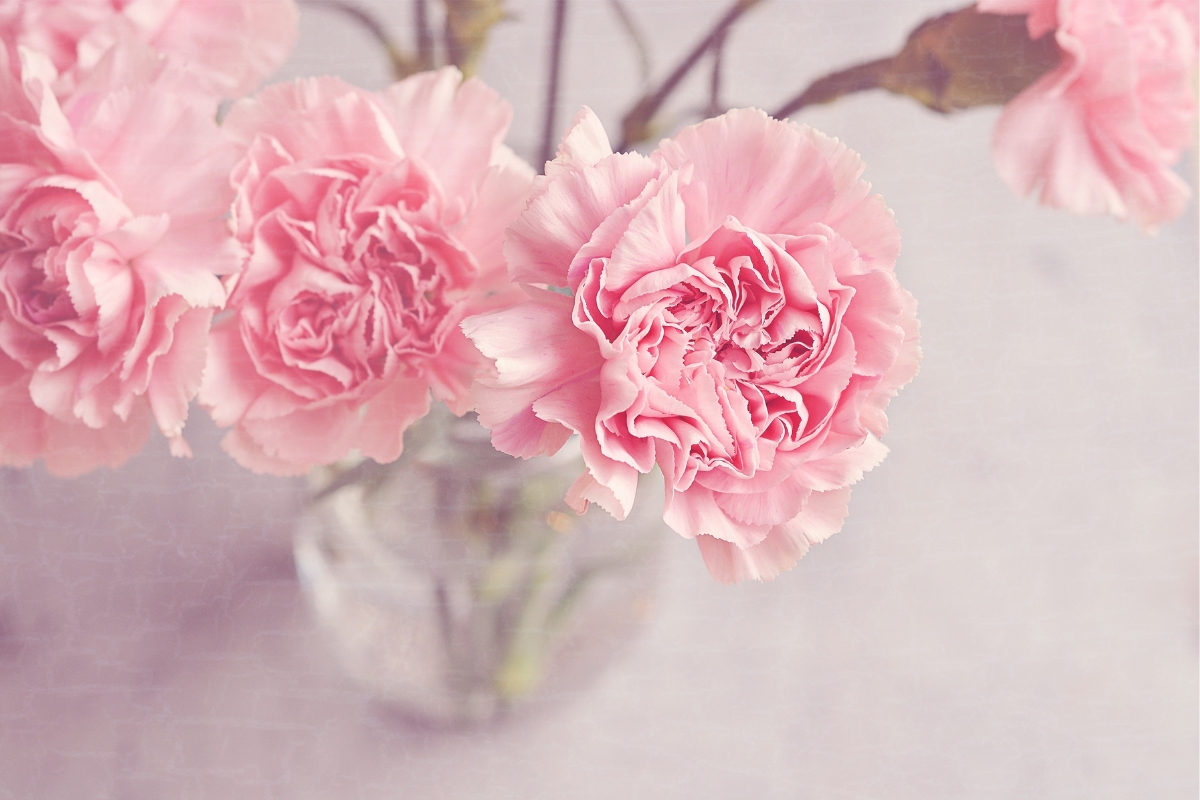
Melt Ice
As a salt, Baking Soda can also help in speeding up the melting process by lowering the freezing temperature of ice. In fact, if your driveways and sidewalks are made out of bricks or concrete, it’ll be less corrosive than the salt usually sold for de-icing (Calcium Chloride).
Baking Soda will take longer to melt ice than table salt, but you might not have that on hand in bulk. Sprinkle the Baking Soda over all icy areas you want to clear. Within 10 minutes you should notice the ice is much less slick than it had been.
Natural Laundry Detergent
You can find several recipes online that will walk you through creating your own detergent. Many of them recommend cooking your Baking Soda to turn it into washing soda. But you can use the Baking Soda as it comes in the box.
Place your clothes in the washer and then add 1 cup of Baking Soda directly to them. As desired, add a few drops of essential oils for scent. Then run your washing like normal.
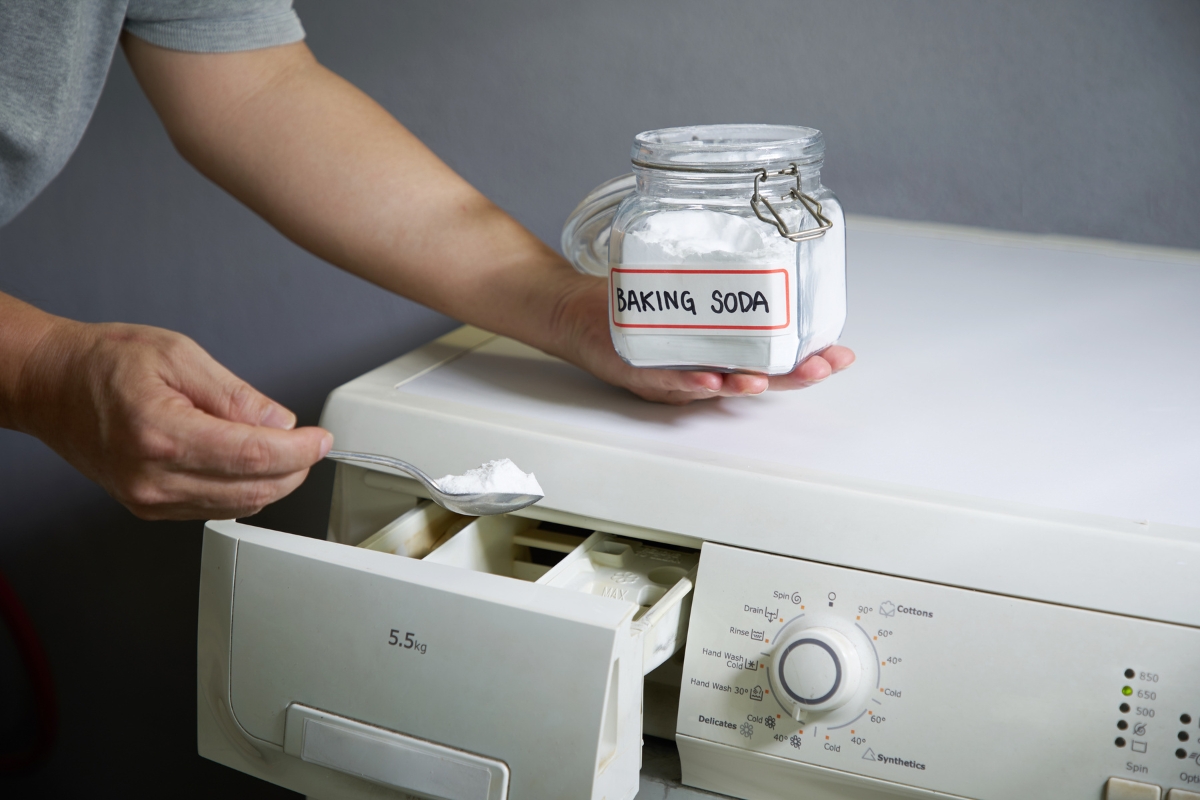
Put out Fires
Let’s be completely upfront: Baking Soda will not help put out a house fire. But it can help put out little fires—like the ones that spring up at the bottom of the oven from time to time.
When appropriate, dump Baking Soda directly onto any flames you want to put out. It isn’t flammable and when heated it releases CO2. This will suffocate the flames and help prevent them from spreading.
Don’t get confused, however: Baking Powder is definitely flammable and will not put out any fires you put it on.
Set up Super Glue
Working on a delicate project and don’t have the time to sit and squish two pieces together while your glue dries? Baking Soda can also help here. Though you’ll need to be prepared to work fast!
Simply sprinkle Baking Soda onto super glue and it will dry in 10 seconds. I’d recommend testing this method out with scraps first to get the hang of it.
Also beware that adding Baking Soda to super glue will cause it to heat up and it may burn skin if it comes in contact with the setting mixture. So wear gloves!
Air Up Balloons
Baking Soda isn’t all grubby chores and smelly drains. Just like the classic vinegar volcano demonstrates, it also can be used for more lighthearted things.
You’ll need a 12in or larger balloon and a 2L bottle. Pour 3 cups of vinegar into the bottle. Then fill the balloon halfway up with Baking Soda (a paper funnel can help here). Without turning the balloon over, snap the opening of the balloon over the mouth of the bottle. Once it’s secured, tip the balloon over to let the Baking Soda fall out and watch your balloon expand!
Garden Uses for Baking Soda
Heading outside now, Baking Soda can be used to help remove many harmful pests from your garden.
Many people claim you can use Baking Soda as an additive in your garden for your plants. But remember, Baking Soda is a salt and will generally harm them. Getting the right ratios of Baking Soda to try and help your garden with is not an area with much consensus. I won’t be including any uses that involve mixing Baking Soda directly into your garden soil here.
Gnat Control
Gnats have a tendency to congregate wherever there’s a lot of consistent water. For potted plants, adjusting your watering schedule to let the soil mostly dry out is the best way to prevent gnats from settling. If they’re already present or your plant likes its feet wet, you can try a Baking Soda spray.
Mix 1 tbs of Baking Soda with 1 gallon of water. Add in 1tbs of dish soap and put the mixture in a spray bottle. Spritz this directly on any gnats you see and in any soil areas where they congregate. Don’t soak the area as this will hurt your plants.
If the gnats persist after a week, switch out for another method to avoid damage to your soil.
Insect Repellent
Are crawling insects trying to invade your garden beds? You can ward them off with a little Baking Soda. Simply sprinkle the Baking Soda on garden paths and on the edges of plant beds. Try to avoid getting it directly onto the soil.
If you have plants growing in your garden path, you will want to avoid adding the Baking Soda on top of them.
Ant and Roach Killer
While not as effective as commercial insecticides, Baking Soda is considerably safer to have around pets and children. This method does combine it with sugar, though, so you’ll want to place it where birds and other animals can’t get to it.
To get rid of ants and roaches, mix 2 tbs Baking Soda with 2 tbs sugar. Add warm water to make it into a paste. If you have spare bottle caps, fill them with the paste and set them out where you see any insects. Otherwise, you can let the mixture dry, crumble it up, and sprinkle it around instead.
Prevent Powdery Mildew
Warm weather and high humidity sometimes lead to spots forming on the leaves of your plants. If it appears to be growing you may have powdery mildew coming in. This is a highly harmful fungus for your plants and will need to be treated quickly. There are a variety of mixtures you can try that use Baking Soda. One is listed below, but with any mixture you try, test is in a small area first to see if it will burn your plants.
Put together a solution of 1 tsp Baking Soda, 2-3 drops dish soap, and 1 qt warm water. Spray this on the affected leaves at the first sign of powdery mildew. It will help stop the mildew in its tracks and prevent it from spreading further. However, it might not fully kill it. Keep an eye on your plants and adjust treatment as needed.
While Baking Soda can help prevent Powdery Mildew from spreading, it isn’t something you should use as a constant deterrent. Instead, make sure your plants are getting plenty of sunshine and lots of air circulation to prevent humidity from sticking to the leaves and stems.
Soil Acidity Test
Most plants don’t need to have the Ph of their soil tested that often. However, some plants are more demanding and there may be local environmental factors that affect the Ph of your soil. If you want to get an idea of where your soil falls on the Ph scale, you can gather some and test it with Baking Soda.
You’ll want 2 cups of soil split into 2 bowls. Pour ½ cup vinegar into one and watch for bubbles. Mix ½ cup water and 1 tsp Baking Soda into the other bowl, and again, watch for bubbles.
If the vinegar solution foams, your soil is more alkaline. If the Baking Soda reacts, it’s more acidic. No reaction at all means your soil is neutral or close to it.
While you can theoretically correct highly acidic soil with Baking Soda, this isn’t recommended as the amount you’d need to use would likely injure your plants. If you’re worried about needing to correct your soil’s Ph, you may want to get a test kit that will pinpoint exactly where your soil is on the scale. From there you can find corrective materials in garden stores.
Weed Control
Unwanted plants have a tendency to pop up in the strangest places: between the cracks of your driveway, behind your potted plants, or even the roof of your carport. Pulling them out takes time and labor no one enjoys.
You can kill off those unwanted plants with Baking Soda. Only choose this method, though, if you don’t want any plants growing in that area. You’ll essentially be salting the soil in that spot and making it unlivable for all plants.
Spray down the weeds with a hose and then cover them in Baking Soda. After a few days they’ll have died and dried up. You can now easily scoop or rake them out. By applying a bit of baking soda over the area regularly, you can also prevent new weeds from growing in.
Baking Soda for Personal Use
Baking Soda is a common ingredient in many items we use while getting ready in the morning. It can remove odors, act as a cleanser, and exfoliate your skin. Make your own hygiene products with a little Baking Soda!
Wearable Deodorant
As we’ve seen elsewhere, Baking Soda is excellent at deodorizing. You’ll want to experiment with the ratios for your own Baking Soda deodorant—while some people can put it straight onto their armpits, most people find this too abrasive and irritating. Find what’s best for your skin, and don’t use it regularly if necessary.
To make the deodorant, mix 1 part Baking Soda with 2 parts water. Likely, you won’t need much. Start with ¼ tsp of soda to ½ tsp water and adjust if you need more. Apply the paste and let it dry.
Mouthwash
Dislike most commercial mouthwashes? You might like to try one based on Baking Soda—it’ll freshen your mouth without the harsh aftertaste of more common washes. Additionally, using a Baking Soda mouthwash can help dry up any sores on your gums or inside your cheeks.
Take 1 tsp of Baking Soda and mix it with a cup of warm water (you can also use lukewarm peppermint tea for a minty taste). Rinse your mouth for a minute and spit out the mixture. It’s very simple but effective!
Toothpaste
You may have heard that you can use Baking Soda to whiten your teeth. And it can! By acting as an abrasive, Baking Soda will gently scrub stains off. People with sensitive teeth will find it’s actually the gentlest whitening agent available.
In a small dish, mix equal parts Baking Soda and water. Dip your toothbrush into the paste and use it like normal. For a little extra cleaning, substitute the water for 3% hydrogen peroxide.
Be wary of any recipes that call for using lemons, strawberries, or vinegar with Baking Soda. All of these contain acids that will damage your teeth if used regularly.
Using a Baking Soda toothpaste has actually been shown to help recovery from dental surgeries. Participants using it had significantly advanced healing over those using a commercial toothpaste.
Homemade Bath Bombs
Don’t want to run to the store for something to spruce up your bath? Or are you looking for a fun handmade gift for a friend? You can make your own fizzy bath bombs with ingredients you might already have at home.
In a large bowl combine 4 tsp cornstarch, 8 tsp unsweetened lemonade mix, and 1/3 cup Baking Soda. Take a second bowl and pour in 1/3 cup mineral or baby oil and add a few drops of food coloring (you can skip this step if desired). Add a little of the mineral oil to the dry ingredients, mixing as you go until it gets the consistency of wet sand.
Put on some gloves, grab a muffin tin, and prepare to work fast! Tightly pack the ingredients into the muffin tin, shaping them into disks. You’ll need to work quickly to avoid your mixture drying out before you’ve shaped the bath bombs. Let them dry for 24 to 48 hours. You can store them in cellophane until you’re ready to use them.
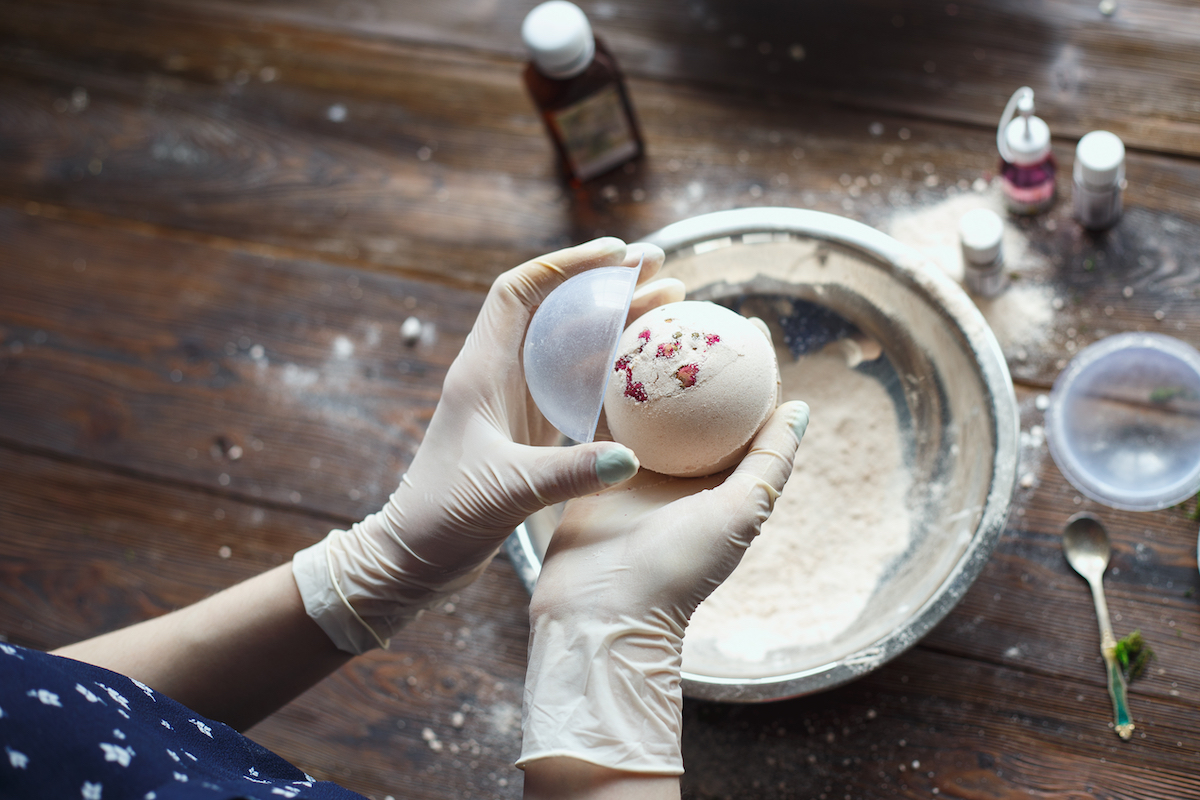
Natural Dry Shampoo
Similar to the Deodorant recipe, you’ll want to test your reaction to a Baking Soda dry shampoo in small stages and adjust as necessary. It will be more abrasive than a baby powder dry shampoo and may not be best suited for hair that’s been dyed or heavily damaged by heat.
Take 1 tbs Baking Soda and mix it with ¼ cup of cornstarch. Extras can be stored in a lidded container of your choice. When you’re ready, take a pinch of your shampoo, rub it on your hands and then run your hands through your hair. Focus on those parts of your hair that feel the greasiest.
If you have darker hair, you can add 2 tbs of cocoa powder to the mix to help the dry shampoo blend in better. You’ll want to experiment with the amount of cocoa powder to find the right shade for your hair. And take notes so you can make it again!
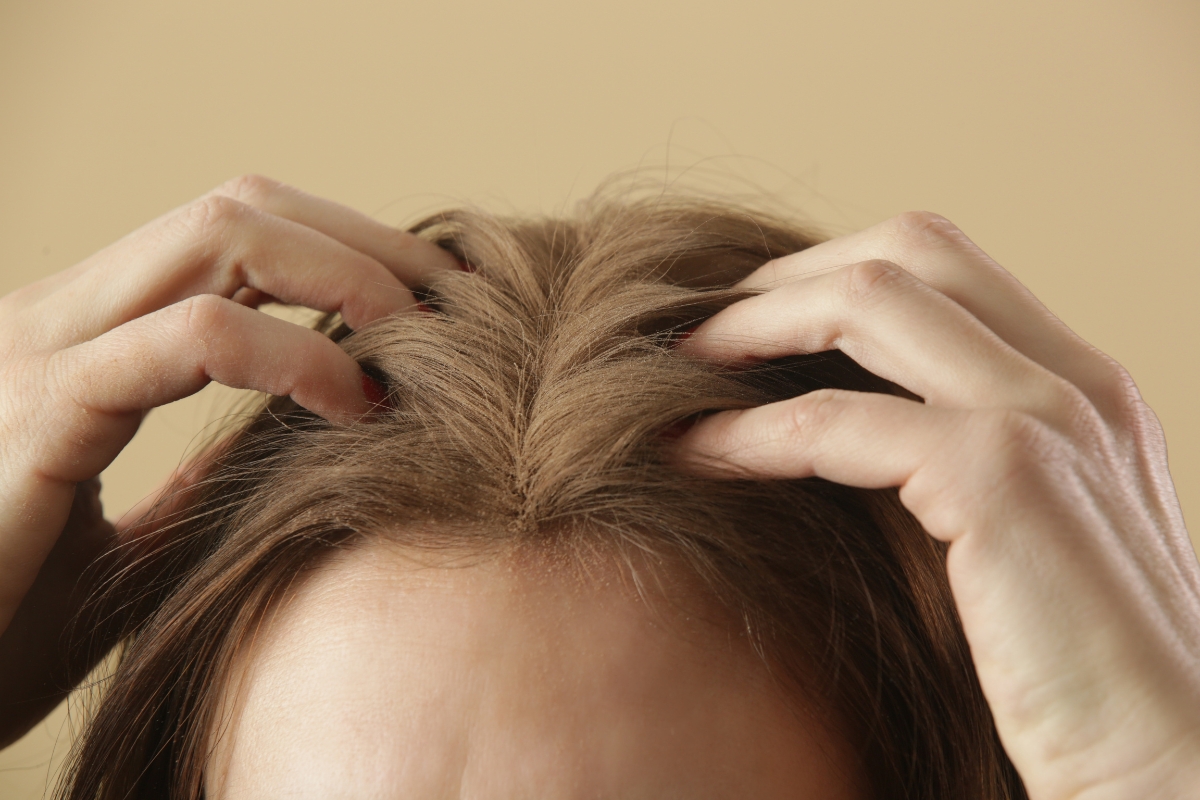
Homemade Exfoliating Scrubs
Buying sugar scrubs and other exfoliating lathers can begin to get pricey after a while. Baking Soda scrubs are gentle enough you can use them on your hands, feet, or face, while still helping to cut through dry, rough skin.
In a jar or container, make a paste containing 3 parts Baking Soda to 1 part water. Wash the area you want to exfoliate. Then, rub the paste in gentle circles for a deep clean and rinse with water.
Brighten Nails
Stains accumulate on your nails just like they can on any hard surface. Whether it’s from home projects or a yellow tint from nail polish, you can use Baking Soda to scrub away the discoloration.
Set out a towel for your hands to rest on. Next, make a paste out of 2 tsp Baking Soda and warm water. Use more water if you have weak or brittle nails to thin the paste out. Apply this to the tops and undersides of your nails. Let your hands rest on the towel with the paste on for 5 minutes. Rinse your nails off, scrubbing lightly. You may need to go through this routine twice.
Clarify Hair
Hard water and heavy products build up in hair after a while, something your shampoo alone might not cut through. To clear out any build up, you can make a clarifying shampoo out of Baking Soda and the shampoo you already use. While highly effective, it can dry out your hair completely and shouldn’t be used regularly.
In a bowl, measure out your usual shampoo amount. Divide that amount by 3 and mix in that much Baking Soda. For example: you typically use 1 ½ tbs shampoo, so you’ll add ½ tbs Baking Soda. Mix the two and use like usual.
Baking Soda for Pets
Having something on hand to clean up and care for your pets is a huge stress reliever. Many of the cleaning applications of Baking Soda apply for your household animals as well. But there’s even more ways you can use Baking Soda in a pinch to care for your pets.
Remove Skunk Smell
Top priority here is to get that smell out fast! Both for the sake of your pet and to avoid the smell getting spread around. Fortunately, you can make a shampoo out of items you most likely have on hand.
Keep your pet outside near a hose if possible. Make up a mixture of ¼ cup Baking Soda, 1 tsp liquid soap, and 1 qt of hydrogen peroxide. If you don’t have a full quart of peroxide on hand, making up the extra with water will work but you’ll need multiple applications.
Shampoo your unfortunate pet, being careful of their eyes, and rinse them quickly to avoid bleaching their fur.
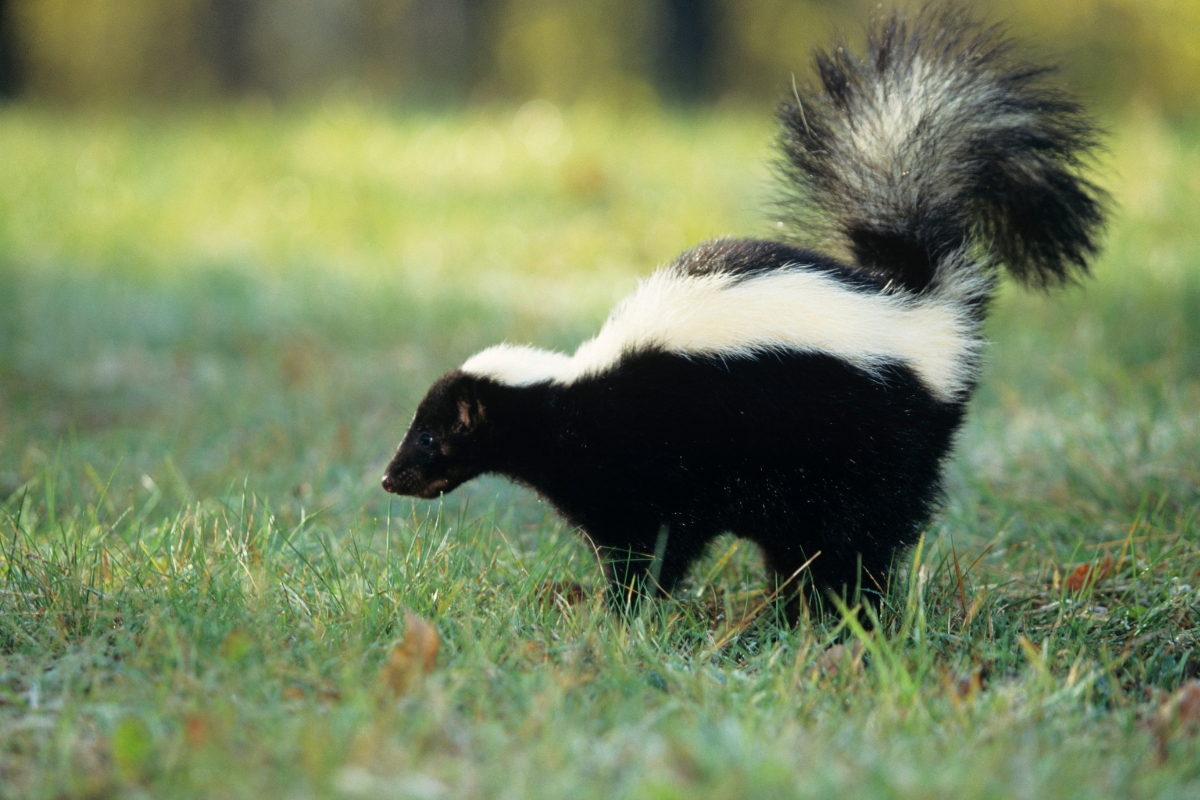
Toenail Trimming Accidents
If you trim your dog’s nails at home you may have cut too deep on occasion. Bleeding should stop quickly and if it doesn’t you can use Baking Soda to slow it down.
Mix equal parts cornstarch and Baking Soda. Dip your dog’s toes into the mixture and apply pressure to the area for a minute or two. The bleeding should stop and your pet will be free to run or lick off the rest.
Wet Shampoo for Dogs
Make your own shampoo to deeply deodorize your dog. You can use the following mixture on its own or as a pre-wash before using a regular dog shampoo.
Take 3 tbs Baking Soda and 1 qt warm water. Wash this into your dog’s coat and let it soak in for a few minutes. Next you can either rinse your pup or shampoo them again. Rinse them thoroughly to avoid itchy skin.
Dry Shampoo for Dogs and Cats
In between full baths it can be nice to spruce up your pet a little. Don’t use this method twice in a row—be sure to give them a full bath in between dry shampoos to avoid drying out their skin.
Begin with a good brushing to remove loose fur or dirt in their coat. Next rub Baking Soda into their fur and massage it in. Leave it for a few minutes and keep your pet from licking their fur during that time. Finally, brush the Baking Soda out and wipe them down with a dry towel.
Small amounts of Baking Soda aren’t harmful, but you’ll want to avoid your pet ingesting too much.
Freshen Kitty Litter
Sprinkling Baking Soda directly onto used litter can help tamp down the smell. But you can also use it to prevent the smell.
Wash your cat’s litter box and sprinkle a generous amount of Baking Soda at the bottom. Fill it with litter like normal. You should notice it will take longer for the box to begin to smell.
Clean Water Bowls
Whether it’s for a cat, dog, or the birds outside, water bowls build up mildew. Regularly replacing the water in these dishes will slow the pace. But about once a week you may need to wash it.
To kill the mildew, use a mixture of Baking Soda, salt, and water to make a thick paste. Scrub the dish and let the mixture sit for a few minutes. Rinse it thoroughly and refill like normal.
Baking Soda for Cooking
A classic kitchen staple, most people use Baking Soda as a leavener. But there are several ways you can use it in your cooking. Keep in mind that Baking Soda keeps indefinitely for all of the uses listed above. But for cooking, an opened box has a shelf life of 6 months. After this time, you may need to increase the amount you use to get the same results.
Leavening in Baked Goods
Baking Soda will help any baked good rise and can be found in many different recipes. This is because it releases CO2 when heated or combined with an acid. Extra air means extra height.
If experimenting in the kitchen without a recipe, keep in mind Baking Soda works best when combined with an acid. While it will still release CO2 when cooked, your results will be better with some buttermilk or lemon juice.
For recipes without any acidic ingredients, you’ll want to use Baking Powder instead.
Removing Bitter Flavors
From coffee to tomato sauce, Baking Soda can help reduce acidic flavors in food. This is a “to taste” method, so start very small and work your way up.
Coffee drinkers generally recommend adding a small pinch of Baking Soda to a brewed cup to mellow the flavor. While you can add it to the basket when making a pot, the ratios get tricky.
For any other dish, start with a good pinch of Baking Soda, taste, and keep going until you reach the flavor you want.
Soften Citrus Peels for Marmalade
Usually making marmalade is a 2 day process. Baking Soda can shorten it to a day by skipping the overnight soak.
Using your favorite recipe, add your peels to a sauce pan and add 1/8 tsp Baking Soda per roughly 8 oranges and 2 lemons worth of peels. Add in 2 ½ cups water and bring the water to a boil, stirring to help the Baking Soda dissolve. Simmer for 20 minutes, then add in the fruit. Simmer for another 10 minutes.
At this point your peels should be softened enough to combine with the pectin for your recipe.
Peel Boiled Eggs
Baking Soda isn’t the most consistent “easy method” for peeling boiled eggs. It won’t correct overcooked eggs (the main culprit), but it can combine with other methods to help guarantee success.
For every quart of water you use, add ½ tsp of Baking Soda. Cook your eggs like normal (but not too much!) and peel away! I like the “water method” at this stage: place the egg in a small cup, add some water, shake like crazy, and the peel should come off).
Crisping Potatoes
Recently, this has become a bit more of a contested kitchen trick. Similarly to using Baking Soda to preserve the color of vegetables, there is concern that using Baking Soda in boiling water reduces the nutritional content of produce. While I think nutrition outweighs color in food (and won’t recommend that Baking Soda trick), if you’re roasting potatoes as a treat it’s perfectly safe to use this method.
Generally, roast potatoes need to be boiled first to avoid burning them in the oven. Adding Baking Soda to the pot helps texturize your potatoes to allow them to crisp up nicely.
Simply add ½ tsp of Baking Soda for every 4 lbs of chopped potatoes you boil. Then season as you like and pop them in the oven.
Fluffy Scrambled Eggs
Eggs can become stubbornly tough and dry while cooking. Even turning the heat down doesn’t always seem to help keep them soft and fluffy.
When scrambling your eggs, add ¼ tsp of Baking Soda for every 4 eggs in the bowl. When cooked, the CO2 from the Baking Soda will help aerate your eggs and keep them fluffed.
Tenderize Meats
Also known as velveting, adding either Baking Soda or Cornstarch to meats ahead of time will tenderize them for the grill or the pan. You can make either a dry rub or a brine to tenderize your meat
For a dry rub: find your meat’s weight in ounces. Measure out 1 percent of that weight in Baking Soda. Rub the Baking Soda into the meat, covering all sides. Refrigerate for 3-5 hours. When ready to cook, remove it and rinse all the Baking Soda off to avoid affecting the flavor.
For a brine: for every 12 ounces of meat, mix 1 tsp of Baking Soda and ½ cup water. Soak the meat for 15 minutes or more, depending on how tough the cut of meat is, keeping it in the refrigerator until done. When ready to cook, remove the meat and rinse it off.
Bronze Pretzels
To bronze pretzels, you actually need Sodium Carbonate. Fortunately, it’s very easy to make Sodium Carbonate if you have Baking Soda on hand.
Take a tray and spread your Baking Soda thinly across the bottom. Next, bake it at 250⁰ F for 1 hour. When it’s done, let it cool and store it in an airtight container.
In your pretzel recipe, you’ll use your Sodium Carbonate (the cooked Baking Soda) to replace the lye bath. For every 8 cups of water in the bath, mix in ¼ Sodium Carbonate. Simmer to make sure it dissolves and you’re ready to go.
Soften Beans
Depending on how hard your water is and how old the beans are, it can be incredibly difficult to get the beans to soften. Baking soda can help break down pectins and is an effective way to help cook dried beans.
Prepare a brine by mixing 3 tbs salt, 1 tsp Baking Soda, 8 ½ cups water, and 1 lb dried beans rinsed and cleared of debris. Soak for the recommended amount of time for your beans of choice. Rinse thoroughly and cook like normal.
Useful Household Staples
Looking for more creative ways to use common everyday household things?
